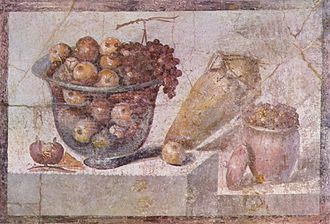Trompe-l'œil
Trompe-l'œil (French for "deceive the eye") is an art technique that uses realistic imagery to create the optical illusion that depicted objects exist in three dimensions. This technique has been employed in painting, murals, and even architecture to trick the viewer's perception and suggest depth on a flat surface. Trompe-l'œil can be traced back to both the Greek and Roman times, where it was used to expand the perceived space of rooms through painted illusions of windows, doors, and hallways.
History
The use of trompe-l'œil dates back to ancient Greece and Rome, where it was used to create the illusion of deeper and more expansive spaces within architectural environments. However, it was during the Renaissance that trompe-l'œil painting truly flourished, as artists sought to demonstrate their mastery over nature through their ability to trick the eye. Artists like Andrea Mantegna and Jacopo da Pontormo made significant contributions to the development of trompe-l'œil. In the 17th century, Dutch and Flemish painters, such as Samuel van Hoogstraten and Cornelis Norbertus Gysbrechts, further advanced the technique, often using it to paint still-life subjects that appeared to extend out of the frame.
Techniques
Trompe-l'œil relies on several techniques to achieve its deceiving effect. Perspective drawing is crucial, as it allows the artist to create a convincing three-dimensional space on a two-dimensional surface. The use of chiaroscuro, a technique that employs strong contrasts between light and dark, enhances the illusion of depth and volume. Additionally, careful attention to detail and texture is necessary to mimic the appearance of the depicted objects accurately.
Applications
While trompe-l'œil is most commonly associated with painting, it has been applied in various forms and mediums. In mural art, it has been used to transform plain walls into the illusion of elaborate architectural features, such as windows, doors, and hallways. In interior design, trompe-l'œil can create the illusion of larger, more open spaces or add decorative elements without physical alterations. Trompe-l'œil has also found applications in theater set design, where it helps in creating the illusion of depth on stage backgrounds.
Contemporary Use
In contemporary art, trompe-l'œil continues to be a popular technique, with artists exploring its potential in new and innovative ways. Digital art and street art have embraced trompe-l'œil to create stunning illusions that interact with their environment in dynamic ways. Artists like Julian Beever and Kurt Wenner have gained fame for their three-dimensional pavement drawings that appear to rise from or sink into the ground.
See Also
Transform your life with W8MD's budget GLP-1 injections from $125.
W8MD offers a medical weight loss program to lose weight in Philadelphia. Our physician-supervised medical weight loss provides:
- Most insurances accepted or discounted self-pay rates. We will obtain insurance prior authorizations if needed.
- Generic GLP1 weight loss injections from $125 for the starting dose.
- Also offer prescription weight loss medications including Phentermine, Qsymia, Diethylpropion, Contrave etc.
NYC weight loss doctor appointments
Start your NYC weight loss journey today at our NYC medical weight loss and Philadelphia medical weight loss clinics.
- Call 718-946-5500 to lose weight in NYC or for medical weight loss in Philadelphia 215-676-2334.
- Tags:NYC medical weight loss, Philadelphia lose weight Zepbound NYC, Budget GLP1 weight loss injections, Wegovy Philadelphia, Wegovy NYC, Philadelphia medical weight loss, Brookly weight loss and Wegovy NYC
|
WikiMD's Wellness Encyclopedia |
| Let Food Be Thy Medicine Medicine Thy Food - Hippocrates |
Medical Disclaimer: WikiMD is not a substitute for professional medical advice. The information on WikiMD is provided as an information resource only, may be incorrect, outdated or misleading, and is not to be used or relied on for any diagnostic or treatment purposes. Please consult your health care provider before making any healthcare decisions or for guidance about a specific medical condition. WikiMD expressly disclaims responsibility, and shall have no liability, for any damages, loss, injury, or liability whatsoever suffered as a result of your reliance on the information contained in this site. By visiting this site you agree to the foregoing terms and conditions, which may from time to time be changed or supplemented by WikiMD. If you do not agree to the foregoing terms and conditions, you should not enter or use this site. See full disclaimer.
Credits:Most images are courtesy of Wikimedia commons, and templates, categories Wikipedia, licensed under CC BY SA or similar.
Contributors: Prab R. Tumpati, MD






